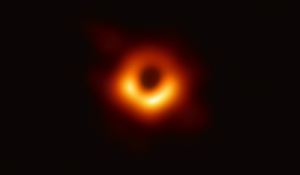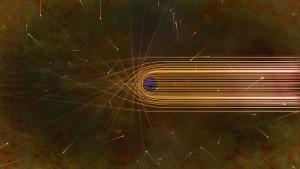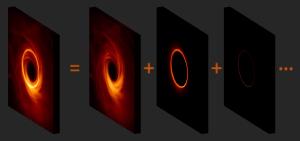Blog
The One Ring
19 March 2020
The supermassive black hole in M87 has a mass of more than 6 billion Suns. It is so large that its event horizon could easily swallow our entire system. It is also 53 million light-years away, which makes it rather difficult to observe. Its apparent size is similar to that of a baseball placed on the surface of the Moon.
To observe such a distant and faint object, it took an international team of radio astronomers. They tied together observatories from all over the world through a process known as interferometry, and created a virtual telescope nearly the size of Earth. Months of gathered data then had to be shipped to computational facilities where the data was processed to create the first direct image of a black hole.
 EHT Collaboration
EHT CollaborationWhile this was a monumental achievement, the image itself seemed rather unimpressive to some. That’s it? All this work for a blurry image with a dark center? What does that tell us about a black hole? Like most radio images, looks can be deceiving. While the black hole image is great for a bit of press, it’s just how we represent the radio data in a visually appealing way.
Even this processed image isn’t an image of the black hole itself. Black holes don’t emit light, so they are effectively invisible. What this image represents is light that has been gravitationally focused in our direction, kind of like the headlight of a car. The black hole is bathed in a glow of radio light, and when some of the light passes close to the black hole the direction changes radically. The only light we see is the light deflected along our line of sight. The dark region is the shadow cast by the black hole within the radio glow.
From this first data astronomers were able to pin down some of the black hole properties, such as its mass and rotation. Of course, astronomers would like to learn even more, which is a challenge given that even this blurry image pushed the limits of our technology. But a new paper published in Science Advances shows how it might be done.1
 Nicolle R. Fuller/NSF
Nicolle R. Fuller/NSFThe key is to understand how light is deflected near a black hole. While a black hole deflects light like a lens, it does so in rather odd ways when the light gets really close. The most common deflection is for the path of light to simply change direction. This is most of the light we see in the black hole image. But get a little closer, and the light can orbit the black hole once before being sent on its way. A bit closer, and it can orbit two times, or three times.
Light taking an ever-closer approach can reach a point where light orbits the black hole indefinitely. Photons can orbit a black hole similar to the way planets orbit a star. This orbit region for light is known as the photon sphere. It marks the limit of a stable orbit around a black hole. General relativity makes strong predictions about the size and shape of the photon shell. If we can observe it, we could test relativity in new ways.
 George Wong (UIUC) and Michael Johnson (CfA)
George Wong (UIUC) and Michael Johnson (CfA)This new research shows how all these different paths are contained in the radio data we gather, and how these layers create distinct signatures within interferometry. In other words, to observe the photon sphere, we don’t need to create ever-sharper images of a black hole. Instead, we can look for these signatures to pull out the data of each layer.
At the moment this technique is beyond the ability of the current Event Horizon Telescope, but it does show how further advances in radio astronomy could lead to a much greater understanding of black holes.
Johnson, Michael D., et al. “Universal Interferometric Signatures of a Black Hole’s Photon Ring.” Science Advances Vol. 6, no. 12, (2020). ↩︎